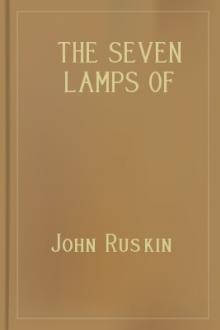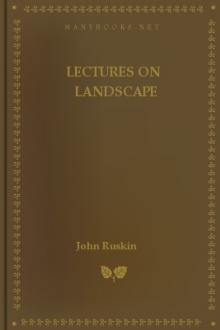The Seven Lamps of Architecture by John Ruskin (books like harry potter TXT) 📕

- Author: John Ruskin
- Performer: -
Book online «The Seven Lamps of Architecture by John Ruskin (books like harry potter TXT) 📕». Author John Ruskin
Portions of an Arcade on the South Side of the Cathedral of Ferrara.
XX. I have, however, given enough instances of vitality shown in mere daring, whether wise, as surely in this last instance, or inexpedient; but, as a single example of the Vitality of Assimilation, the faculty which turns to its purposes all material that is submitted to it, I would refer the reader to the extraordinary columns of the arcade on the south side of the Cathedral of Ferrara. A single arch of it is given in Plate XIII. on the right. Four such columns forming a group, there are interposed two pairs of columns, as seen on the left of the same plate; and then come another four arches. It is a long arcade of, I suppose, not less than forty arches, perhaps of many more; and in the grace and simplicity of its stilted Byzantine curves I hardly know its equal. Its like, in fancy of column, I certainly do not know; there being hardly two correspondent, and the architect having been ready, as it seems, to adopt ideas and resemblances from any sources whatsoever. The vegetation growing up the two columns is fine, though bizarre; the distorted pillars beside it suggest images of less agreeable character; the serpentine arrangements founded on the usual Byzantine double knot are generally graceful; but I was puzzled to account for the excessively ugly type of the pillar, fig. 3, one of a group of four. It so happened, fortunately for me, that there had been a fair in Ferrara; and, when I had finished my sketch of the pillar, I had to get out of the way of some merchants of miscellaneous wares, who were removing their stall. It had been shaded by an awning supported by poles, which, in order that the covering might be raised or lowered according to the height of the sun, were composed of two separate pieces, fitted to each other by a rack, in which I beheld the prototype of my ugly pillar. It will not be thought, after what I have above said of the inexpedience of imitating anything but natural form, that I advance this architect's practice as altogether exemplary; yet the humility is instructive, which condescended to such sources for motives of thought, the boldness, which could depart so far from all established types of form, and the life and feeling, which out of an assemblage of such quaint and uncouth materials, could produce an harmonious piece of ecclesiastical architecture.
XXI. I have dwelt, however, perhaps, too long upon that form of vitality which is known almost as much by its errors as by its atonements for them. We must briefly note the operation of it, which is always right, and always necessary, upon those lesser details, where it can neither be superseded by precedents, nor repressed by proprieties.
I said, early in this essay, that hand-work might always be known from machine-work; observing, however, at the same time, that it was possible for men to turn themselves into machines, and to reduce their labor to the machine level; but so long as men work as men, putting their heart into what they do, and doing their best, it matters not how bad workmen they may be, there will be that in the handling which is above all price: it will be plainly seen that some places have been delighted in more than others—that there has been a pause, and a care about them; and then there will come careless bits, and fast bits; and here the chisel will have struck hard, and there lightly, and anon timidly; and if the man's mind as well as his heart went with his work, all this will be in the right places, and each part will set off the other; and the effect of the whole, as compared with the same design cut by a machine or a lifeless hand, will be like that of poetry well read and deeply felt to that of the same verses jangled by rote. There are many to whom the difference is imperceptible; but to those who love poetry it is everything—they had rather not hear it at all, than hear it ill read; and to those who love Architecture, the life and accent of the hand are everything. They had rather not have ornament at all, than see it ill cut—deadly cut, that is. I cannot too often repeat, it is not coarse cutting, it is not blunt cutting, that is necessarily bad; but it is cold cutting—the look of equal trouble everywhere—the smooth, diffused tranquillity of heartless pains—the regularity of a plough in a level field. The chill is more likely, indeed, to show itself in finished work than in any other—men cool and tire as they complete: and if completeness is thought to be vested in polish, and to be attainable by help of sand paper, we may as well give the work to the engine-lathe at once. But right finish is simply the full rendering of the intended impression; and high finish is the rendering of a well intended and vivid impression; and it is oftener got by rough than fine handling. I am not sure whether it is frequently enough observed that sculpture is not the mere cutting of the form of anything in stone; it is the cutting of the effect of it. Very often the true form, in the marble, would not be in the least like itself. The sculptor must paint with his chisel: half his touches are not to realize, but to put power into the form: they are touches of light and shadow; and raise a ridge, or sink a hollow, not to represent an actual ridge or hollow, but to get a line of light, or a spot of darkness. In a coarse way, this kind of execution is very marked in old French woodwork; the irises of the eyes of its chimeric monsters being cut boldly into holes, which, variously placed, and always dark, give all kinds of strange and startling expressions, averted and askance, to the fantastic countenances. Perhaps the highest examples of this kind of sculpture-painting are the works of Mino da Fiesole; their best effects being reached by strange angular, and seemingly rude, touches of the chisel. The lips of one of the children on the tombs in the church of the Badia, appear only half finished when they are seen close; yet the expression is farther carried and more ineffable, than in any piece of marble I have ever seen, especially considering its delicacy, and the softness of the child-features. In a sterner kind, that of the statues in the sacristy of St. Lorenzo equals it, and there again by incompletion. I know no example of work in which the forms are absolutely true and complete where such a result is attained; in Greek sculptures is not even attempted.
XXII. It is evident that, for architectural appliances, such masculine handling, likely as it must be to retain its effectiveness when higher finish would be injured by time, must always be the most expedient; and as it is impossible, even were it desirable that the highest finish should be given to the quantity of work which covers a large building, it will be understood how precious the intelligence must become, which renders incompletion itself a means of additional expression; and how great must be the difference, when the touches are rude and few, between those of a careless and those of a regardful mind. It is not easy to retain anything of their character in a copy; yet the reader will find one or two illustrative points in the examples, given in Plate XIV., from the bas-reliefs of the north of Rouen Cathedral. There are three square pedestals under the three main niches on each side of it, and one in the centre; each of these being on two sides decorated with five quatrefoiled panels. There are thus seventy quatrefoils in the lower ornament of the gate alone, without counting those of the outer course round it, and of the pedestals outside: each quatrefoil is filled with a bas-relief, the whole reaching to something above a man's height. A modern architect would, of course, have made all the five quatrefoils of each pedestal-side equal: not so the Mediæval. The general form being apparently a quatrefoil composed of semicircles on the sides of a square, it will be found on examination that none of the arcs are semicircles, and none of the basic figures squares. The latter are rhomboids, having their acute or obtuse angles uppermost according to their larger or smaller size; and the arcs upon their sides slide into such places as they can get in the angles of the enclosing parallelogram, leaving intervals, at each of the four angles, of various shapes, which are filled each by an animal. The size of the whole panel being thus varied, the two lowest of the five are tall, the next two short, and the uppermost a little higher than the lowest; while in the course of bas-reliefs which surrounds the gate, calling either of the two lowest (which are equal), a, and either of the next two b, and the fifth and sixth c and d, then d (the largest): c::c:a::a:b. It is wonderful how much of the grace of the whole depends on these variations.
XXIII. Each of the angles, it was said, is filled by an animal. There are thus 70 x 4=280 animals, all different, in the mere fillings of the intervals of the bas-reliefs. Three of these intervals, with their beasts, actual size, the curves being traced upon the stone, I have given in Plate XIV.
Sculpture from the Cathedral of Rouen.
I say nothing of their general design, or of the lines of the wings and scales, which are perhaps, unless in those of the central dragon, not much above the usual commonplaces of good ornamental work; but there is an evidence in the features of thoughtfulness and fancy which is not common, at least now-a-days. The upper creature on the left is biting something, the form of which is hardly traceable in the defaced stone—but biting he is; and the reader cannot but recognise in the peculiarly reverted eye the expression which is never seen, as I think, but in the eye of a dog gnawing something in jest, and preparing to start away with it: the meaning of the glance, so far as it can be marked by the mere incision of the chisel, will be felt by comparing it with the eye of the couchant figure on the right, in its gloomy and angry brooding. The plan of this head, and the nod of the cap over its brow, are fine; but there is a little touch above the hand especially well meant: the fellow is vexed and puzzled in his malice; and his hand is pressed hard on his cheek bone, and the flesh of the cheek is wrinkled under the eye by the pressure. The whole, indeed, looks wretchedly coarse, when it is seen on a scale in which it is naturally compared with delicate figure etchings; but considering it as a mere filling of an interstice on the outside of a cathedral gate, and as one of more than three hundred (for in my estimate I did not include the outer pedestals), it proves very noble vitality in the art of the time.
XXIV. I believe the right question to ask, respecting all ornament, is simply this: Was it done with enjoyment—was the carver happy while he was about it? It may be the hardest work possible, and the harder





Comments (0)